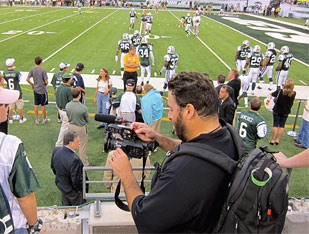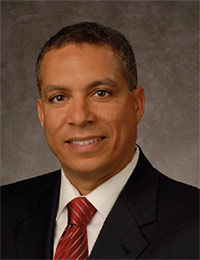The Cure for TV Sports Boredom
TORONTO
The disease is TV Sports Boredom. It occurs when viewers repeatedly see the same style of sports highlights and features on the 6:00 news. TV Sports Boredom is caused by poor editing decisions, exacerbated by a lack of creativity and a preference for routine.
The tragedy of TV Sports Boredom doesn't have to happen. It fact, it can be entirely prevented by people who push the envelope when they edit sports highlights and features. Although there are many ways to push the envelope—as this article will detail—preventing TV Sports Boredom comes down to one simple rule: "Just because we did things a certain way in the past," says CBS Sports Vice President of Production Harold Bryant, "does not mean we have to keep doing them the same way now."
Bryant is very serious about creative sports video editing. This is why "The NFL on CBS"' production crew attended a video editing seminar before the 2010-2011 regular season began. "We challenge our editors to stay current on the latest editing systems and production styles," he said. "This is why we support them in attending classes and seminars, so that their editing stays fresh."

Stephen Spiegel, Producer/Director/Editor, Metro SportsFOCUS ON STORY-TELLING
Staying fresh has helped Producer/Director/Editor Stephen Spiegel win 18 Regional Emmys over the years. In line with Bryant's advice, Spiegel, who owns SpiegelCreative in Kansas City, Mo., does whatever he can to stay abreast of editing technology. However, he credits his success to effective story-telling; in making sports videos that are interesting to watch.
"Although there is only so much you can do with the highlights—people will always want to know who scored and when—you should still focus on story-telling in everything you do," said Spiegel. In sports highlights, this means providing the viewer with commentary that actually tells them something, rather than a string of synonyms for 'Won' and 'Lost'. In sports features and documentaries, "it means telling the athlete's story both on and off of the field," Spiegel said. "You need to tell the viewers what makes these athletes unique and compelling as human beings. They're much more than a number on a jersey."
SPICING UP THE VIDEO
Despite the simplicity of their format, it is possible to make each sports highlights more than a collection of clips and cliches.
At CBS Sports, "we put a lot of heavy duty editing into our highlight packages, to make them eye-catching and interesting," Bryant said. In quick-turnaround in-game highlights, pulled directly off the server seconds after they happened, "we employ different camera angles and use effects such as slo-mo, stop-motion and digitally zooming in on a critical element of the play to give the clip impact. We also try to mix things up by colorizing the video or customizing the graphics, right down to creating a thematic look for a specific day or occasion."
Spiegel uses visual montages (rapid successions of moving and/or still images) to make his sports videos pop. "I like to break up the video; grab your attention with a startling image, graphics or edited sequence to refresh the audience's interest," he said. "I also take responsibility for my video: if it doesn't interest me, I know it will not interest my audience. And I am willing to do things that might be seen as 'wrong', editing-wise, if I think it will result in compelling video."
Need ideas? Then take a look at what's being done in music videos and commercials, Bryant advises. "We're not ashamed to say that we look closely at what's being done creatively in other forms of television, to see how they can be adapted for sports video," he said. "The kind of style you see in Nike commercials translates well to sports video, and vice versa. In fact, we often notice cutting styles that we've originated turning up later in commercials."

Harold Bryant, CBS Sports Vice President of ProductionDON'T FORGET THE SOUND
When it comes to sports video, the audio is just as important as the video. Ignoring this fact is a prime cause of TV Sports Boredom; caused when editors use the same music bed (i.e. "Eye of the Tiger") over and over again.
CBS Sports takes its music beds very seriously. "We are always on the lookout for new music; whether stock, off-the-shelf commercial, or originally composed," Bryant said. "We even commission artists to prepare music beds for us. For instance, we commissioned Jayzee to customize 'Run This Town' for the Super Bowl XLIV show intro. He performed it for us with Rihanna and the Rutgers Symphony Orchestra; talk about impressive!"
Innovative sound extends to the narration used in sports video. For instance, you can add variety to a highlights package by using the players' own comments rather than an announcer reeling off scores and stats. "You get to hear the player talk about the play as you're seeing it happen," Bryant said. "That can be far more interesting and insightful to the viewer, rather than showing the play and then a talking head player interview."
Spiegel likes to equip game players with wireless mics so that he can capture their comments for later use. "Wireless mics have become so cheap, that you afford to put them on high school athletes," he said. "When the kids are in the heat of the game, they forget all about the microphones. This allows you to capture their words and feelings unguarded and accurate. When connected to the video—either in highlights or longer form pieces—it adds an extra layer of immediacy and context that pulls the viewer in."
There is no reason that TV viewers have to contract TV Sports Boredom. But it is up to TV producers and editors to prevent this disease, by staying creative and innovative in their video editing.
"At CBS Sports, we are committed to making highlights and features that are fresh and different," said Bryant. "Good is never good enough: We are always pushing the envelope to make our sports video better and better."
Get the TV Tech Newsletter
The professional video industry's #1 source for news, trends and product and tech information. Sign up below.
James Careless is an award-winning journalist who has written for TV Technology since the 1990s. He has covered HDTV from the days of the six competing HDTV formats that led to the 1993 Grand Alliance, and onwards through ATSC 3.0 and OTT. He also writes for Radio World, along with other publications in aerospace, defense, public safety, streaming media, plus the amusement park industry for something different.

